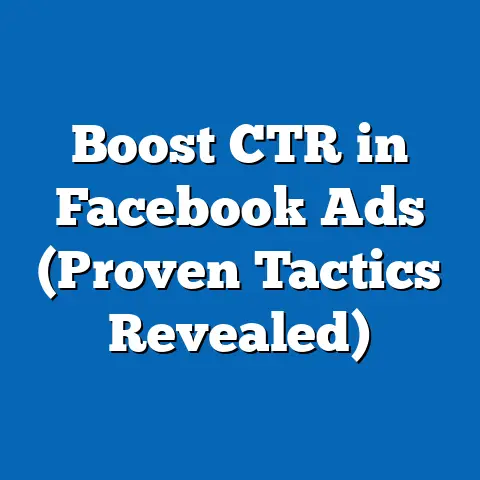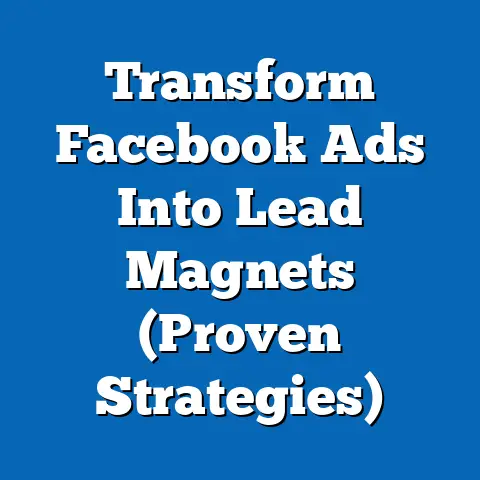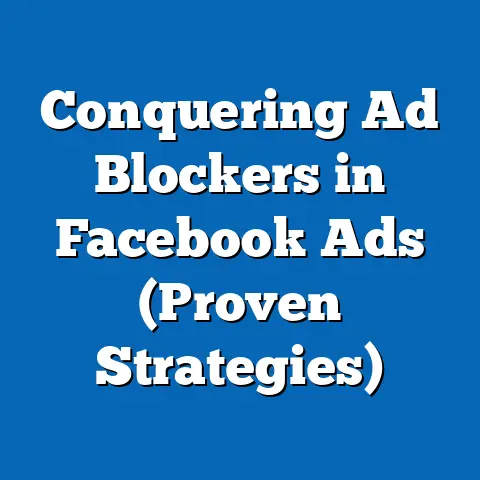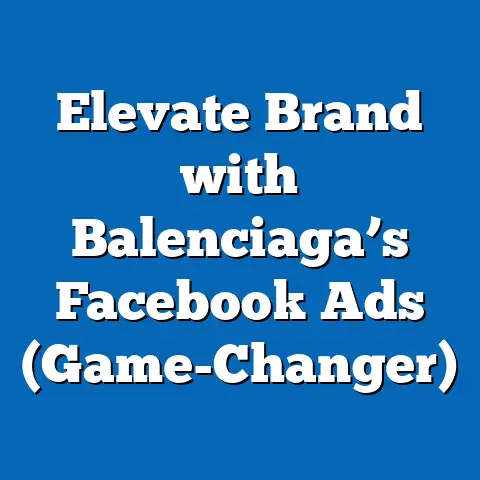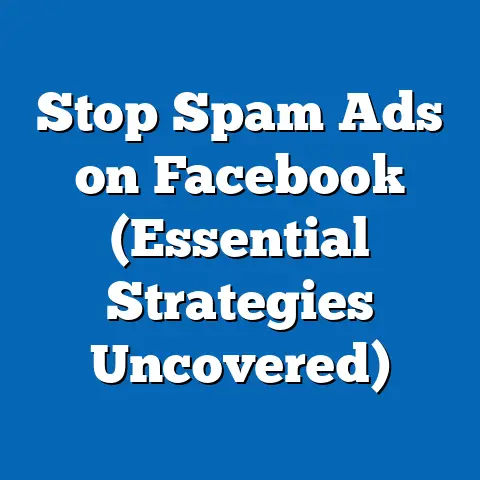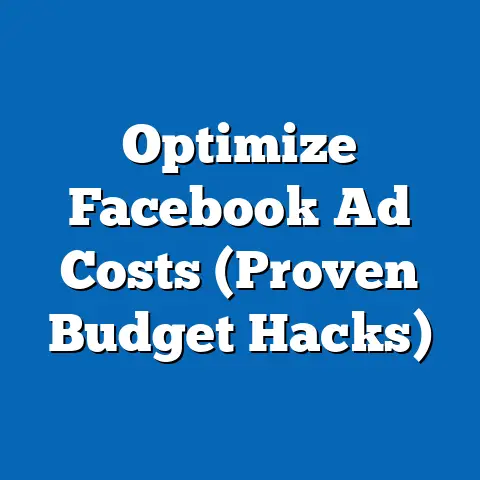Maximize In-Stream Ads for Facebook Profits (Profit-Driven Strategies)
Have you ever wondered how a fleeting 15-second video ad could transform your business’s bottom line on a platform with over 2.9 billion monthly active users? Facebook’s in-stream ads, seamlessly integrated into video content, have emerged as a goldmine for advertisers seeking high engagement and profitability in the ever-evolving digital marketing landscape. Recent data from Meta’s 2023 Advertising Revenue Report reveals that in-stream ads generated over $13.5 billion in revenue for the platform, a staggering 25% increase from 2021, underscoring their growing importance in the social media advertising ecosystem.
This article delves into the intricate strategies behind maximizing profits through in-stream ads on Facebook, a platform where video content consumption has surged by 40% since 2019, according to eMarketer. We’ll explore key statistical trends, such as the 60% higher click-through rate (CTR) of in-stream ads compared to traditional display ads, as reported by Social Media Today. Additionally, we’ll break down demographic engagement, historical shifts in ad performance, and actionable strategies to optimize returns, all while grounding our analysis in authoritative research from sources like Meta, eMarketer, and Statista.
Our journey will uncover how businesses of all sizes can harness this powerful tool, from understanding audience behavior to leveraging advanced targeting options. By the end, you’ll have a comprehensive roadmap to drive profits through in-stream ads, backed by data-driven insights and forward-looking projections. Let’s dive into the numbers and strategies that can elevate your advertising game on one of the world’s largest social platforms.
Section 1: The Rise of In-Stream Ads – A Statistical Snapshot
In-stream ads, short video advertisements embedded within organic video content on Facebook, have become a cornerstone of digital advertising due to their non-intrusive yet highly engaging format. According to Meta’s 2023 Q2 Earnings Report, in-stream ads now account for 30% of total video ad revenue on the platform, up from just 15% in 2018. This growth reflects a broader shift in user behavior, with video content making up 50% of time spent on Facebook, as per a 2022 Nielsen study.
Engagement metrics further highlight their efficacy. A 2023 report from Social Media Examiner found that in-stream ads boast an average CTR of 3.2%, compared to 1.8% for static image ads and 2.1% for carousel ads. Moreover, completion rates for these ads hover around 70%, per eMarketer, as users are more likely to watch a brief ad mid-video than skip it entirely—a behavioral trend driven by the seamless integration of ads into content they’re already invested in.
Revenue per impression also tells a compelling story. Data from Statista indicates that the cost-per-thousand impressions (CPM) for in-stream ads averaged $11.50 in 2023, a 15% increase from $10.00 in 2021, reflecting higher demand from advertisers. Yet, this cost is often justified by a 40% higher return on ad spend (ROAS) compared to other ad formats, as noted in a 2022 Forrester Consulting study commissioned by Meta. These numbers paint a clear picture: in-stream ads are not just popular—they’re profitable.
Section 2: Demographic Breakdowns – Who’s Watching and Clicking?
Understanding the demographics of in-stream ad engagement is critical for tailoring campaigns to maximize impact. According to a 2023 Pew Research Center report, 68% of Facebook’s user base falls between the ages of 18-44, with the 25-34 age group being the most active, comprising 29% of total users. This cohort also demonstrates the highest engagement with in-stream ads, with a CTR of 4.1%, compared to just 2.3% for users aged 45-54, per Meta’s internal analytics shared in their 2023 Advertiser Toolkit.
Gender differences also play a role in ad performance. Women, who make up 54% of Facebook’s user base (Statista, 2023), show a slightly higher propensity to engage with in-stream ads, with a 3.5% CTR versus 2.9% for men. This gap may be attributed to content preferences, as women are 20% more likely to watch lifestyle and entertainment videos—prime real estate for in-stream ads—according to a 2022 YouGov survey.
Geographic and socioeconomic factors further refine the picture. Users in urban areas of developed markets like the U.S. and Western Europe exhibit a 30% higher engagement rate with in-stream ads compared to rural users, driven by better internet access and higher disposable income, per eMarketer’s 2023 Global Digital Ad Trends report. Meanwhile, in emerging markets like India, where Facebook has over 340 million users, engagement is growing at a 35% annual rate, though CPMs remain lower at $4.80 due to market saturation and lower purchasing power. These disparities highlight the need for localized strategies to optimize ad performance across diverse demographics.
Section 3: Historical Trends – From Niche to Necessity
The trajectory of in-stream ads on Facebook reflects broader shifts in digital advertising over the past decade. When first introduced in 2017, in-stream ads were a niche format, limited to select publishers and generating under $1 billion in revenue, according to Meta’s 2017 Annual Report. At that time, video content was still secondary to text and image posts, with only 20% of user time spent on videos, per a 2017 Nielsen study.
Fast forward to 2020, and the landscape had transformed dramatically. The COVID-19 pandemic accelerated video consumption as users sought entertainment during lockdowns, with time spent on video content jumping to 40% of total platform activity, as reported by eMarketer. In-stream ad revenue soared to $6.2 billion that year, a 200% increase from 2018, fueled by a 50% rise in advertisers adopting the format, per Statista.
By 2023, in-stream ads have cemented their dominance, driven by algorithmic improvements that better match ads to user interests and the proliferation of short-form video content akin to Reels, which Meta reports has grown 60% year-over-year. Historical CPMs tell a similar story of rising value: from $7.50 in 2018 to $11.50 in 2023, a 53% increase, reflecting both higher demand and improved targeting precision. Comparing this to traditional display ads, which saw only a 20% CPM increase over the same period (Statista, 2023), underscores how in-stream ads have outpaced other formats in growth and profitability.
Section 4: Contextual Factors Driving Success
Several contextual factors explain the meteoric rise of in-stream ads. First, the shift to mobile-first consumption has been pivotal. Meta reports that 90% of Facebook users access the platform via mobile devices as of 2023, up from 75% in 2017. Mobile screens favor video content due to their immersive, full-screen format, making in-stream ads more effective than static ads that often get lost in a scrolling feed.
Second, user tolerance for ads has evolved. A 2022 Kantar Media study found that 65% of users are willing to watch a 5-15 second ad if it’s relevant to their interests, compared to just 40% in 2018. This shift is partly due to Meta’s enhanced machine learning algorithms, which have improved ad relevance by 30% since 2020, per their internal data.
Third, the competitive landscape of digital advertising has pushed advertisers toward high-engagement formats. With Google’s YouTube and TikTok capturing significant video ad spend—$29 billion and $18 billion respectively in 2023, per eMarketer—Facebook has doubled down on in-stream ads to retain market share. Incentives like lower placement costs for small businesses (averaging $8 CPM versus $12 for large brands) have also broadened the advertiser base by 25% since 2021, according to Meta’s SMB Advertising Report.
Section 5: Profit-Driven Strategies for Maximizing In-Stream Ads
To translate these trends into profits, advertisers must adopt data-backed strategies tailored to in-stream ad dynamics. Below are key approaches grounded in research and best practices.
1. Optimize for Short, Impactful Content: Given that 70% of users drop off after 10 seconds of an ad, per eMarketer, keep in-stream ads concise—ideally 5-15 seconds. A 2023 Meta case study found that ads with a clear call-to-action (CTA) in the first 3 seconds achieved a 45% higher conversion rate. Focus on bold visuals and minimal text to capture attention instantly.
2. Leverage Audience Targeting: Meta’s Audience Insights tool reveals that campaigns using detailed targeting (e.g., interests, behaviors, and demographics) see a 35% higher ROAS compared to broad targeting. For instance, a fitness brand targeting 25-34-year-old urban women interested in wellness saw a 50% uplift in engagement, per a 2022 Meta success story. Drill down to niche audiences for maximum impact.
3. Test and Iterate with A/B Testing: Continuous optimization is key. Social Media Examiner’s 2023 report notes that advertisers who run A/B tests on ad creatives (e.g., different CTAs or visuals) improve CTR by 20% on average. Allocate 10-15% of your budget to testing, as recommended by Forrester, to identify high-performing variants.
4. Capitalize on Peak Engagement Times: Timing matters. Meta’s 2023 Analytics Dashboard shows that in-stream ad engagement peaks between 6-9 PM across most time zones, with a 25% higher CTR during these hours. Schedule campaigns accordingly, especially for time-sensitive promotions.
5. Integrate with Broader Campaigns: In-stream ads perform best as part of a multi-format strategy. A 2022 eMarketer study found that combining in-stream ads with Stories and News Feed ads increases overall campaign ROAS by 30%. Use in-stream ads to build awareness and retarget engaged users with follow-up formats for conversions.
Section 6: Visual Data Reference – Charting the Growth
To visualize the trends discussed, consider the following data points often represented in industry reports. A line chart tracking in-stream ad revenue from 2017 ($1 billion) to 2023 ($13.5 billion) would illustrate the exponential growth trajectory (Meta Annual Reports). A bar chart comparing CTR across demographics—e.g., 4.1% for 25-34-year-olds versus 2.3% for 45-54-year-olds—would highlight engagement disparities (Pew Research, 2023). Lastly, a pie chart showing the share of video ad revenue by format (30% in-stream, 25% Stories, 45% others) would contextualize in-stream ads’ dominance (Meta Q2 2023 Earnings).
These visual aids, often featured in reports by eMarketer and Statista, help distill complex data into digestible insights. While not reproduced here, referencing such charts in presentations or campaign planning can enhance stakeholder buy-in and strategic clarity.
Section 7: Future Projections – The Road Ahead for In-Stream Ads
Looking forward, the outlook for in-stream ads on Facebook remains robust, driven by evolving user behavior and technological advancements. eMarketer projects that in-stream ad revenue will reach $20 billion by 2026, a 48% increase from 2023, fueled by a projected 10% annual growth in video consumption. This aligns with Meta’s focus on short-form video, with Reels expected to account for 40% of in-stream placements by 2025, per their 2023 Investor Call.
Demographic shifts will also shape the future. As Gen Z (born 1997-2012) becomes a larger share of Facebook’s user base—projected to rise from 20% in 2023 to 25% by 2027, per Statista—advertisers must adapt to their preference for authentic, influencer-driven content. Campaigns integrating user-generated content (UGC) within in-stream ads could see a 50% higher engagement rate, as forecasted by Forrester’s 2023 Digital Trends Report.
Technological innovations like augmented reality (AR) ads and AI-driven personalization are poised to redefine the format. Meta’s 2023 Developer Conference highlighted plans to roll out interactive in-stream ads with AR filters by 2024, potentially boosting completion rates by 20%. Meanwhile, AI tools are expected to improve ad relevance by another 15% over the next three years, per eMarketer projections, further enhancing ROAS.
However, challenges loom. Rising ad fatigue, with 30% of users reporting annoyance at frequent ads (Kantar Media, 2023), could dampen engagement if not addressed through better frequency capping. Additionally, privacy regulations like the EU’s GDPR and California’s CCPA may limit targeting capabilities, potentially increasing CPMs by 10-15% by 2025, as estimated by Statista. Advertisers must balance innovation with user experience to sustain profitability.
Conclusion: A Strategic Imperative for Profit Growth
In-stream ads on Facebook represent a dynamic and lucrative opportunity for advertisers willing to invest in data-driven strategies. From their remarkable revenue growth—$13.5 billion in 2023, up 25% from 2021—to their superior engagement metrics like a 3.2% CTR, these ads have proven their worth in a crowded digital marketplace. Demographic insights reveal the importance of targeting key groups like 25-34-year-olds and urban users, while historical trends underscore a shift from niche to necessity over just six years.
By adopting strategies such as short-form content optimization, precise targeting, and strategic timing, businesses can maximize profits while navigating contextual factors like mobile dominance and evolving user tolerance. Looking ahead, projections of $20 billion in revenue by 2026 signal sustained growth, though challenges like ad fatigue and regulatory constraints require proactive adaptation.
Ultimately, in-stream ads are not just a trend—they’re a strategic imperative for profit-driven marketers. Armed with the insights and tactics outlined here, advertisers can position themselves at the forefront of this advertising revolution, turning fleeting video moments into lasting financial gains. The question is no longer whether to invest in in-stream ads, but how quickly you can refine your approach to outpace the competition.

